- Home
- Barbara Ehrenreich
Had I Known
Had I Known Read online
Compilation copyright © 2020 by Barbara Ehrenreich
Jacket copyright © 2020 by Hachette Book Group, Inc.
Hachette Book Group supports the right to free expression and the value of copyright. The purpose of copyright is to encourage writers and artists to produce the creative works that enrich our culture.
The scanning, uploading, and distribution of this book without permission is a theft of the author’s intellectual property. If you would like permission to use material from the book (other than for review purposes), please contact [email protected]. Thank you for your support of the author’s rights.
Twelve
Hachette Book Group
1290 Avenue of the Americas, New York, NY 10104
twelvebooks.com
twitter.com/twelvebooks
The essays in this collection were previously published and may have been slightly revised for this edition.
First Edition: March 2020
Twelve is an imprint of Grand Central Publishing. The Twelve name and logo are trademarks of Hachette Book Group, Inc.
The publisher is not responsible for websites (or their content) that are not owned by the publisher.
The Hachette Speakers Bureau provides a wide range of authors for speaking events. To find out more, go to www.hachettespeakersbureau.com or call (866) 376-6591.
Additional copyright/credits information is here.
LCCN: 2019950073
ISBNs: 978-1-4555-4367-0 (hardcover), 978-1-4555-4368-7 (ebook)
E3-20191223-NF-DA-ORI
Contents
Cover
Title Page
Copyright
Introduction
HAVES AND HAVE-NOTS Nickel-and-Dimed: On (Not) Getting By in America
How You Can Save Wall Street
S&M As Public Policy
Going to Extremes: CEOs vs. Slaves
Are Illegal Immigrants the Problem?
What’s So Great about Gated Communities?
Is It Now a Crime to Be Poor?
A Homespun Safety Net
Dead, White, and Blue: The Great Die-Off of America’s Blue-Collar White People
HEALTH Welcome to Cancerland
The Naked Truth about Fitness
Got Grease?
Our Broken Mental Health System
Liposuction: The Key to Energy Independence
The Selfish Side of Gratitude
MEN How “Natural” Is Rape?
The Warrior Culture
At Last, a New Man
Patriarchy Deflated
WOMEN Are Women Getting Sadder? Or Are We All Just Getting a Lot More Gullible?
Our Neighborhood Porn Committee
Strategies of Corporate Women
What Abu Ghraib Taught Me
Making Sense of “la Différence”
Outclassed: Sexual Harassment
GOD, SCIENCE, AND JOY Mind Your Own Business
The Animal Cure
The Missionary Position
The New Creationism: Biology under Attack
Up Close at Trinidad’s Carnival
BOURGEOIS BLUNDERS Family Values
The Cult of Busyness
Death of a Yuppie Dream
The Unbearable Being of Whiteness
Is the Middle Class Doomed?
Welcome to Fleece U.
Prewatched TV
The Recession’s Racial Divide
Divisions of Labor
Throw Them Out with the Trash: Why Homelessness Is Becoming an Occupy Wall Street Issue
Acknowledgments
Discover More Barbara Ehrenreich
About the Author
OTHER BOOKS AUTHORED OR CO-AUTHORED BY BARBARA EHRENREICH
Explore book giveaways, sneak peeks, deals, and more.
Tap here to learn more.
Introduction
Back in the fat years—two or three decades ago, when the “mainstream” media were booming—I was able to earn a living as a freelance writer. My income was meager, and I had to hustle to get it, turning out about four articles—essays, reported pieces, reviews—a month at $1 or $2 a word. One of the things I wanted to write about, in part for obvious personal reasons, was poverty and inequality, but I’d do just about anything—like, I cringe to say, “The Heartbreak Diet” for a major fashion magazine—to pay the bills.
It wasn’t easy to interest glossy magazines in poverty in the 1980s and ’90s. I once spent two hours over an expensive lunch—paid for, of course, by a major publication—trying to pitch to a clearly indifferent editor who finally conceded, over decaf espresso and crème brûlée, “OK, do your thing on poverty. But can you make it upscale?” (Yes, I found a way to do this.) Then there was the editor of a quite liberal magazine who responded to my pitch for a story involving blue-collar men by asking, “Hmm, but can they talk?” (Actually, my husband was one of them.)
I finally got lucky at Harper’s, where fabled editor Lewis Lapham gave me an assignment that turned into a book, which in turn became a best seller, Nickel and Dimed: On (Not) Getting By in America. Thanks to the royalties and subsequent speaking fees, at last I could begin to undertake projects without concern for the pay, just because they seemed important to me. This was the writing life I had always dreamed of—adventurous, obsessively fascinating, and sufficiently remunerative that I could help support less affluent members of my family.
In the years that followed, I wrote about America’s shifting class contours, the criminalization of poverty, sexual harassment, the racial wealth gap, as well as any other subject that attracted me—from the automation of war to Americans’ apparent belief that they can live forever if only they eat the right combination of veggies and nuts. I paid my bills and, better yet, I was having fun.
Meanwhile, though I didn’t see it at first, the world of journalism as I had known it was beginning to crumble around me. Squeezed to generate more profits for billionaire newspaper owners and new media conglomerates, newsrooms laid off reporters, who often went on to swell the crowds of hungry freelancers. Once-generous magazines shrank or slashed their freelance budgets; there were no more free lunches.
True, the internet was filled with a multiplicity of new outlets to write for, but paying writers or other “content providers” turned out not to be part of their business plan. I saw my own fees at one major news outlet drop to one-third of their value between 2004 and 2009. I heard from younger journalists who were scrambling for adjunct jobs or doing piecework in “corporate communications.” But I determined to carry on writing about the subjects that gripped me, especially poverty and inequality, even if I had to finance my efforts entirely on my own. And I felt noble for doing so.
Then, as the kids say today, I “checked my privilege.” I realized that there was something wrong with an arrangement whereby a relatively affluent person, such as I had become, could afford to write about minimum-wage jobs, squirrels as an urban food source, or the penalties for sleeping in parks, while the people who were actually experiencing these sorts of things, or were in danger of experiencing them, could not.
In the last few years, I’ve gotten to know a number of people who are at least as qualified writers as I am, especially when it comes to the subject of poverty, but who’ve been held back by their own poverty. There’s Darryl Wellington, for example, a local columnist (and poet) in Santa Fe who has, at times, had to supplement his tiny income by selling his plasma—a fallback that can have serious health consequences. Or Joe Williams, who, after losing an editorial job, was reduced to writing for $50 a piece for online political sites while mowing lawns and working in a sporting goods store for $10 an hour to pay for a room in a friend’s house. Linda Tirado was blogging about her job as a cook at IHOP when she managed t
o snag a contract for a powerful book titled Hand to Mouth (for which I wrote the preface). Now she is working on a “multimedia mentoring project” to help other working-class journalists get published.
There are many thousands of people like these—gifted journalists who want to address serious social issues but cannot afford to do so in a media environment that thrives by refusing to pay, or pay anywhere near adequately, its “content providers.” Some were born into poverty and have stories to tell about coping with low-wage jobs, evictions, or life as a foster child. Others inhabit the once-proud urban “creative class,” which now finds itself priced out of its traditional neighborhoods, like Park Slope or LA’s Echo Park, scrambling for health insurance and child care, sleeping on other people’s couches. They want to write—or do photography or make documentaries. They have a lot to say, but it’s beginning to make more sense to apply for work as a cashier or a fry cook.
This is the real face of journalism today: not million-dollar-a-year anchorpersons, but low-wage workers and downwardly spiraling professionals who can’t muster up expenses to even start on the articles, photo essays, and videos they want to do, much less find an outlet to cover the costs of doing them. You can’t, as I learned from Darryl Wellington, hop on a plane to cover a police shooting in your hometown if you don’t have a credit card.
This impoverishment of journalists impoverishes journalism. We come to find less and less in the media about the people who work from paycheck to paycheck, as if 80 percent of the population had quietly emigrated while the other 20 percent wasn’t looking. Media outlets traditionally neglected stories about the downtrodden because they don’t sit well on the same page with advertisements for diamonds and luxury homes. And now there are fewer journalists on hand at major publications to arouse the conscience of editors and other gatekeepers. Coverage of poverty accounts for less than 1 percent of American news, or, as former Times columnist Bob Herbert has put it: “We don’t have coverage of poverty in this country. If there is a story about poor people in the New York Times or in the Washington Post, that’s the exception that proves the rule. We do not cover poverty. We do not cover the poor.”
As for commentary about poverty—a disproportionate share of which issues from very well-paid, established columnists like David Brooks of the New York Times and George Will of the Washington Post—all too often, it tends to reflect the historical biases of economic elites, that the poor are different than “we” are, less educated, intelligent, self-disciplined, and more inclined to make “bad lifestyle choices.” If the pundits sometimes sound like Republican presidential candidates, this is not because there is a political conspiracy afoot. It’s just what happens when the people who get to opine about inequality are drawn almost entirely from the top of the income distribution.
It hurts the poor and the economically precarious when they can’t see themselves reflected in the collective mirror that is the media. They begin to feel that they are indeed different and somehow unworthy, compared to the “mainstream.” But it also potentially hurts the rich.
In a highly polarized society like our own, the wealthy have a special stake in keeping honest journalism about class and inequality alive. Burying an aching social problem does not solve it. The rich and their philanthropies need to step up and support struggling journalists and the slender projects that try to keep them going. As Nick Hanauer, a self-proclaimed member of the 0.01 percent, warned other members of his class in 2018: “If we don’t do something to fix the glaring inequities in this economy, the pitchforks are going to come for us.”
At an age when most people retire—or are pushed out of the workforce into low-paid work as home health aides, valet parkers, or babysitters—I am fortunate enough to be able to keep on writing about the things that inflame my curiosity or fill me with moral outrage. But mostly I try, through a nonprofit I helped create, the Economic Hardship Reporting Project, to launch struggling journalists who otherwise might never be heard from on account of their poverty or skin color, gender or sexual orientation, youth or age. It’s a great joy to me to work with people like Darryl, Joe, Linda, and so many others, and to see them begin to thrive. In the spirit of torch-passing, I dedicate this book to them.
Barbara Ehrenreich
May 2019
HAVES AND HAVE-NOTS
Nickel-and-Dimed: On (Not) Getting By in America
Harper’s Magazine, 1999
At the beginning of June 1998 I leave behind everything that normally soothes the ego and sustains the body—home, career, companion, reputation, ATM card—for a plunge into the low-wage workforce. There, I become another, occupationally much diminished “Barbara Ehrenreich”—depicted on job-application forms as a divorced homemaker whose sole work experience consists of housekeeping in a few private homes. I am terrified, at the beginning, of being unmasked for what I am: a middle-class journalist setting out to explore the world that welfare mothers are entering, at the rate of approximately 50,000 a month, as welfare reform kicks in. Happily, though, my fears turn out to be entirely unwarranted: during a month of poverty and toil, my name goes unnoticed and for the most part unuttered. In this parallel universe where my father never got out of the mines and I never got through college, I am “baby,” “honey,” “blondie,” and, most commonly, “girl.”
My first task is to find a place to live. I figure that if I can earn $7 an hour—which, from the want ads, seems doable—I can afford to spend $500 on rent, or maybe, with severe economies, $600. In the Key West area, where I live, this pretty much confines me to flophouses and trailer homes—like the one, a pleasing fifteen-minute drive from town, that has no air-conditioning, no screens, no fans, no television, and, by way of diversion, only the challenge of evading the landlord’s Doberman pinscher. The big problem with this place, though, is the rent, which at $675 a month is well beyond my reach. All right, Key West is expensive. But so is New York City, or the Bay Area, or Jackson Hole, or Telluride, or Boston, or any other place where tourists and the wealthy compete for living space with the people who clean their toilets and fry their hash browns.1 Still, it is a shock to realize that “trailer trash” has become, for me, a demographic category to aspire to.
So I decide to make the common trade-off between affordability and convenience, and go for a $500-a-month efficiency thirty miles up a two-lane highway from the employment opportunities of Key West, meaning forty-five minutes if there’s no road construction and I don’t get caught behind some sun-dazed Canadian tourists. I hate the drive, along a roadside studded with white crosses commemorating the more effective head-on collisions, but it’s a sweet little place—a cabin, more or less, set in the swampy back yard of the converted mobile home where my landlord, an affable TV repairman, lives with his bartender girlfriend. Anthropologically speaking, a bustling trailer park would be preferable, but here I have a gleaming white floor and a firm mattress, and the few resident bugs are easily vanquished.
Besides, I am not doing this for the anthropology. My aim is nothing so mistily subjective as to “experience poverty” or find out how it “really feels” to be a long-term low-wage worker. I’ve had enough unchosen encounters with poverty and the world of low-wage work to know it’s not a place you want to visit for touristic purposes; it just smells too much like fear. And with all my real-life assets—bank account, IRA, health insurance, multiroom home—waiting indulgently in the background, I am, of course, thoroughly insulated from the terrors that afflict the genuinely poor.
No, this is a purely objective, scientific sort of mission. The humanitarian rationale for welfare reform—as opposed to the more punitive and stringy impulses that may actually have motivated it—is that work will lift poor women out of poverty while simultaneously inflating their self-esteem and hence their future value in the labor market. Thus, whatever the hassles involved in finding child care, transportation, etc., the transition from welfare to work will end happily, in greater prosperity for all. Now there are many problems wi
th this comforting prediction, such as the fact that the economy will inevitably undergo a downturn, eliminating many jobs. Even without a downturn, the influx of a million former welfare recipients into the low-wage labor market could depress wages by as much as 11.9 percent, according to the Economic Policy Institute (EPI) in Washington, DC.
But is it really possible to make a living on the kinds of jobs currently available to unskilled people? Mathematically, the answer is no, as can be shown by taking $6 to $7 an hour, perhaps subtracting a dollar or two an hour for child care, multiplying by 160 hours a month, and comparing the result to the prevailing rents. According to the National Coalition for the Homeless, for example, in 1998 it took, on average nationwide, an hourly wage of $8.89 to afford a one-bedroom apartment, and the Preamble Center for Public Policy estimates that the odds against a typical welfare recipient’s landing a job at such a “living wage” are about 97 to 1. If these numbers are right, low-wage work is not a solution to poverty and possibly not even to homelessness.
It may seem excessive to put this proposition to an experimental test. As certain family members keep unhelpfully reminding me, the viability of low-wage work could be tested, after a fashion, without ever leaving my study. I could just pay myself $7 an hour for eight hours a day, charge myself for room and board, and total up the numbers after a month. Why leave the people and work that I love? But I am an experimental scientist by training. In that business, you don’t just sit at a desk and theorize; you plunge into the everyday chaos of nature, where surprises lurk in the most mundane measurements. Maybe, when I got into it, I would discover some hidden economies in the world of the low-wage worker. After all, if 30 percent of the workforce toils for less than $8 an hour, according to the EPI, they may have found some tricks as yet unknown to me. Maybe—who knows?—I would even be able to detect in myself the bracing psychological effects of getting out of the house, as promised by the welfare wonks at places like the Heritage Foundation. Or, on the other hand, maybe there would be unexpected costs—physical, mental, or financial—to throw off all my calculations. Ideally, I should do this with two small children in tow, that being the welfare average, but mine are grown and no one is willing to lend me theirs for a month-long vacation in penury. So this is not the perfect experiment, just a test of the best possible case: an unencumbered woman, smart and even strong, attempting to live more or less off the land.

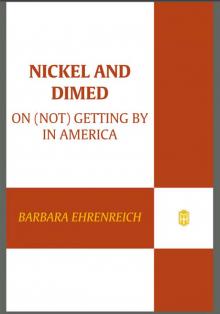 Nickel and Dimed: On (Not) Getting by in America
Nickel and Dimed: On (Not) Getting by in America Living With a Wild God
Living With a Wild God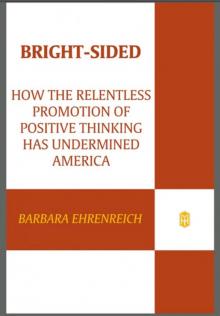 Bright-Sided
Bright-Sided Bait and Switch: The (Futile) Pursuit of the American Dream
Bait and Switch: The (Futile) Pursuit of the American Dream Dancing in the Streets: A History of Collective Joy
Dancing in the Streets: A History of Collective Joy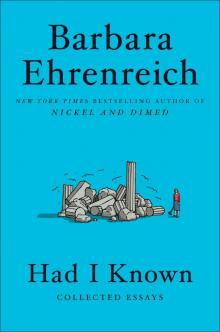 Had I Known
Had I Known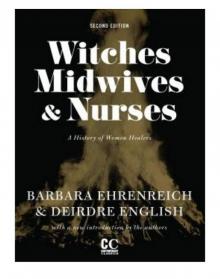 Witches, Midwives, and Nurses
Witches, Midwives, and Nurses For Her Own Good: Two Centuries of the Experts Advice to Women
For Her Own Good: Two Centuries of the Experts Advice to Women Nickel and Dimed
Nickel and Dimed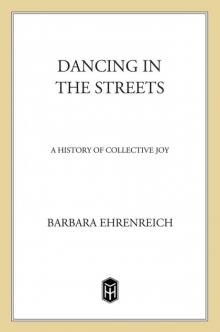 Dancing in the Streets
Dancing in the Streets Bait and Switch
Bait and Switch